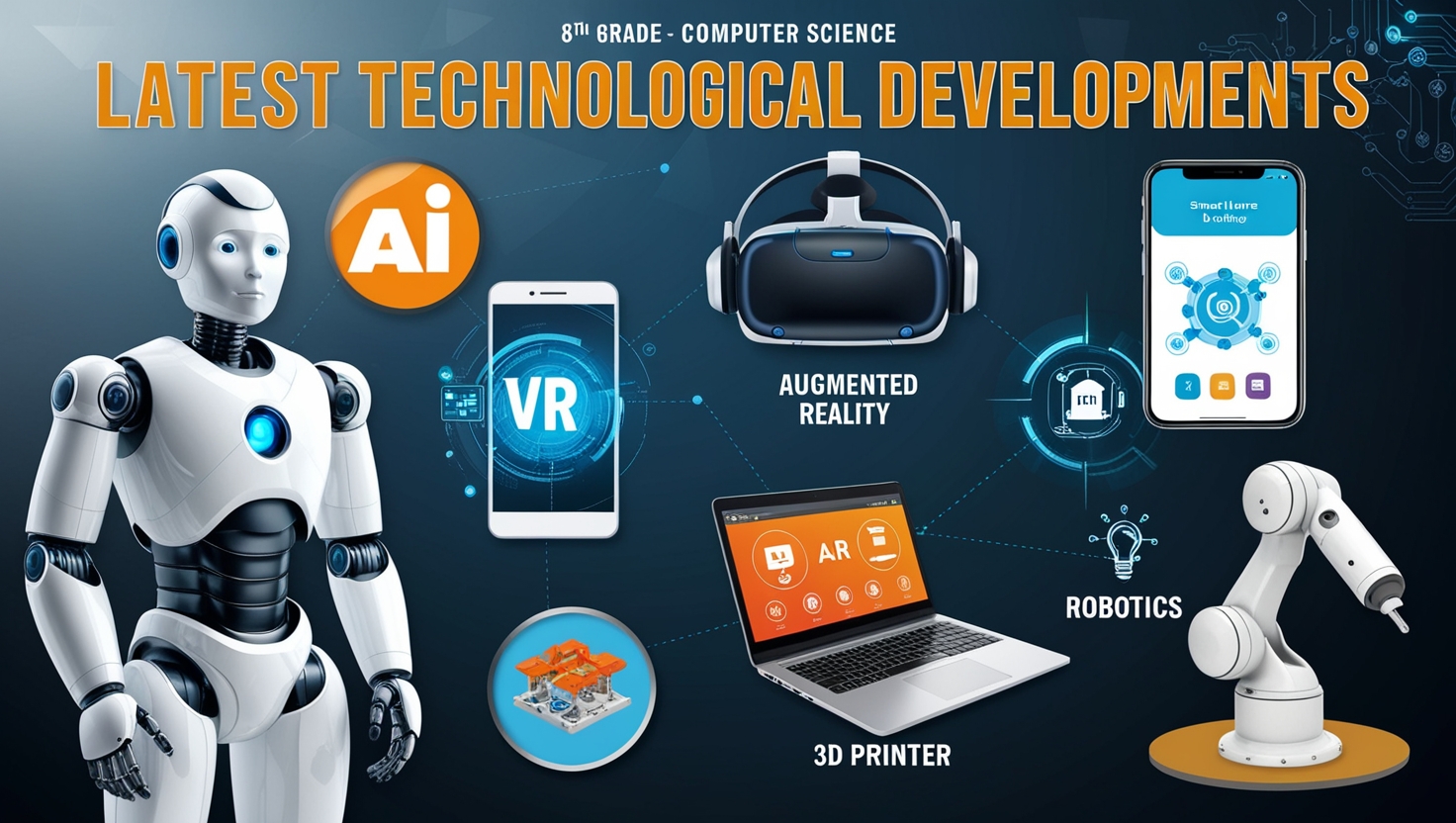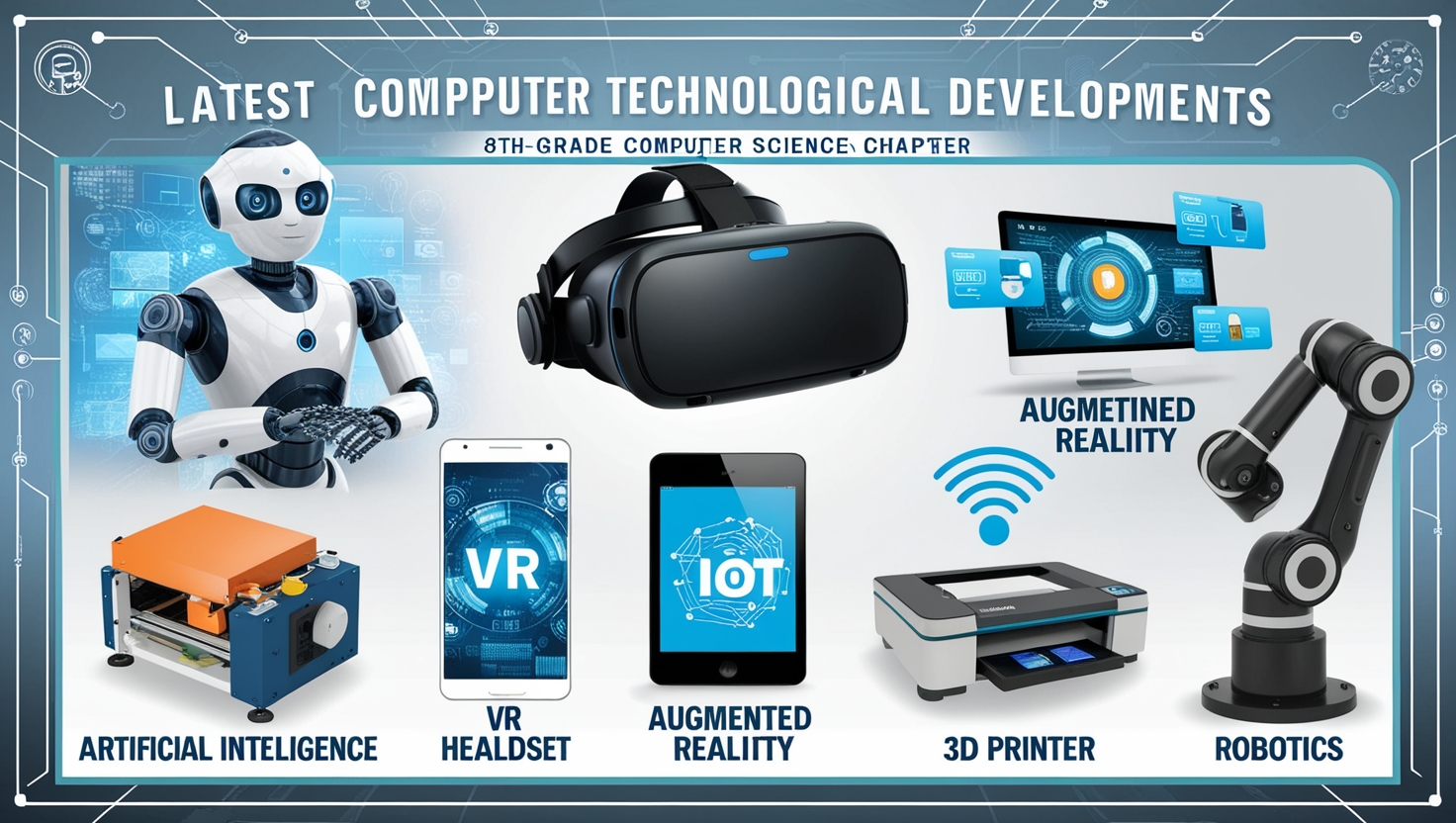Touchpad Computer Book Class 8 Ch 6 solution
Ch. 6 Latest Technological Developments
Introduction: The world of technology is advancing at an incredible pace, transforming the way we live, learn, and work. For students in the 8th grade, understanding these advancements is essential to becoming informed, tech-savvy individuals. In this chapter, “Latest Technological Developments,” students will explore the most exciting innovations in computer science and technology, including Artificial Intelligence (AI), Virtual Reality (VR), Augmented Reality (AR), the Internet of Things (IoT), 3D Printing, and Robotics. Each of these technologies plays a unique role in shaping our future, offering new possibilities and challenges. Touchpad Computer Book Class 8 Ch. 6 solution
What You Will Learn:
This chapter introduces students to cutting-edge technologies, their applications, and the impact they have on various industries. Here’s a breakdown of each topic covered:

1. Artificial Intelligence (AI):
What is AI? AI refers to machines programmed to mimic human intelligence. These machines can analyze data, recognize patterns, and make decisions. Applications of AI include personal assistants like Siri and Alexa, predictive text, and even self-driving cars. Through AI, computers are helping solve complex problems in medicine, finance, and many other fields. Students will learn how AI works, why it’s important, and the role it may play in their own futures.
2. Virtual Reality (VR) and Augmented Reality (AR):
- VR creates a fully immersive, digital experience. By wearing VR headsets, users can explore simulated environments that look and feel real.
- AR overlays digital elements onto the real world through a device, such as a smartphone camera. For instance, apps like Pokémon Go allow users to see virtual objects in real surroundings.
- These technologies have applications in gaming, education, training, and entertainment. Students will discover how VR and AR help people learn in new ways, like simulating medical surgeries or exploring distant planets. Touchpad Computer Book Class 8 Ch 6 solution
3. Internet of Things (IoT):
IoT refers to the network of devices that connect and exchange data over the internet. Common IoT devices include smart home gadgets like thermostats, security systems, and wearable fitness trackers.
- Why It Matters: IoT makes life more convenient, but it also raises questions about data privacy and security. Students will explore how IoT is shaping smart homes, cities, and industries.
4. 3D Printing:
3D printing, also known as additive manufacturing, allows the creation of three-dimensional objects by layering materials. This technology has applications in medicine (like printing prosthetic limbs), architecture, and even fashion.
- Learning Highlights: Students will learn how 3D printing works and discuss its potential to revolutionize manufacturing by making it faster and more cost-effective.
5. Robotic Process Automation (RPA):
RPA uses software robots or “bots” to automate repetitive tasks in businesses, such as data entry or customer support. It helps reduce human error and frees people to focus on more complex work.
- Why It’s Important: Students will understand how RPA is transforming industries and enabling companies to operate more efficiently.
Conclusion:
By the end of this chapter, students will have a solid understanding of today’s most impactful technologies and their real-world applications. This knowledge will not only help them in their studies but also inspire them to consider future careers in technology, where they could be part of the next wave of innovation. Touchpad Computer Book Class 8 Ch 6 solution
Touchpad Computer Book Class 8 Ch. 6 solution
1. Tick (✓) the correct option.
a. _____ is not an area of application of AI.
- (i) Expert system
- (ii) Natural Language Processing
- (iii) 3D Printing
- (iv) Robotics
Answer: (iii) 3D Printing is not an area of application of AI.
b. The app _____ uses the GPS location of the smartphone and the camera to collect information about the user’s surroundings.
- (i) Star Walk
- (ii) Layar
- (iii) Mimo
- (iv) Compass
Answer: (ii) Layar
c. The camera in the device _____ recognizes and tracks the user’s hand gestures with the help of computer-vision techniques.
- (i) SixthSense
- (ii) Google Glass
- (iii) Oculus Rift
- (iv) Mimo
Answer: (i) SixthSense
d. _____ is not a type of 3D Printing.
- (i) Indirect 3D printing
- (ii) Direct 3D printing
- (iii) Binder 3D printing
- (iv) Fused Deposition Modeling
Answer: (i) Indirect 3D printing
e. The system of connected computing devices creating a virtual network is known as _____.
- (i) VR
- (ii) IoT
- (iii) RPA
- (iv) AR
Answer: (ii) IoT.

2. Fill in the blanks using the words from the help box.
Help Box: Shakey, Virtual, RP, Augmented Reality, RPA
a. _____ is the blending of Virtual Reality and real life.
Answer: Augmented Reality
b. The purpose of _____ is to transfer the execution of the process from humans to robots.
Answer: RPA
c. _____ was the first robot to use AI to navigate.
Answer: Shakey
d. In _____ Reality, a virtual world is created that users can interact with.
Answer: Virtual
e. _____ method is used to create models to quickly test a new product before mass production.
Answer: RP (Rapid Prototyping)
3. Write ‘T’ for true and ‘F’ for false.
a. I-Apps are software written for mobile devices based on robotics and machine learning technology.
Answer: T
b. Facial recognition software and video surveillance cameras are examples of pattern recognition software.
Answer: T
c. 3D Printing was first developed at MIT (Massachusetts Institute of Technology) in 2005.
Answer: F
d. The system where biological materials like cells and growth factors are fused to create tissue-like structures replicating their natural equivalents is called bioprinting.
Answer: T
e. Robotic automation creates a new IT structure with complex system integrations.
Answer: F.
4. Short answer type questions.
a. What is AI?
Answer: AI (Artificial Intelligence) is a branch of computer science aimed at creating systems that simulate human intelligence, enabling machines to learn, reason, communicate, and make decisions.
b. Write a short note on Pattern recognition.
Answer: Pattern recognition is a field in AI that identifies regularities and patterns in data, enabling applications like facial recognition, fingerprint identification, and speech recognition to make accurate predictions or classifications.
c. What do you mean by Rapid prototyping?
Answer: Rapid prototyping is a technique used to quickly create a model of a new product. It allows testing of the product’s design before it goes into mass production, often using 3D printing methods.
d. What is RPA? Explain.
Answer: RPA (Robotic Process Automation) is the use of software robots to automate repetitive tasks. It transfers task execution from humans to robots within existing IT infrastructure, improving efficiency and reducing human errors.
e. What is I-Apps?
Answer: I-Apps, or Intelligent Apps, are applications for mobile devices powered by AI and machine learning. They aim to make tasks easier by adapting to users’ preferences and usage patterns.
5. Long answer type questions.
a. Write short notes on the following:
(i) Expert systems
Answer: Expert systems are AI-based software that emulate human expertise in specific fields. They are designed to solve complex problems by mimicking the reasoning of human experts.(ii) Natural language processing
Answer: NLP (Natural Language Processing) is a branch of AI that focuses on enabling computers to understand, interpret, and respond to human language in a meaningful way.(iii) Intelligent agents
Answer: Intelligent agents are autonomous programs with built-in intelligence to monitor user tasks and perform actions on their behalf. Examples include virtual assistants like Siri or Alexa.(iv) AR
Answer: Augmented Reality (AR) blends digital elements with the real world, enhancing what users see and interact with. Applications include navigation, gaming, and virtual try-ons.(v) VR
Answer: Virtual Reality (VR) immerses users in a completely digital environment, often used in gaming, simulations, and education. Users can interact with the virtual world as if it were real.
b. List the applications of AR and VR.
Answer:
- Applications of AR: SixthSense device, Google Glass, Star Walk, virtual try-on tools.
- Applications of VR: Oculus Rift, VR in education, VR in medical training, immersive gaming.
c. Explain Internet of Things with suitable examples.
Answer: The Internet of Things (IoT) is a network of interconnected devices that communicate and share data without human intervention. Examples include smart thermostats, wearable fitness trackers, and connected home appliances like smart refrigerators and lights.
d. Write the applications of 3D Printing.
Answer:
- Applications of 3D Printing:
- Education: Creating models for teaching.
- Medicine: Producing prosthetics and custom implants.
- Construction: Printing building components.
- Art and Jewelry: Crafting intricate designs and personalized items.
e. Distinguish between AR and VR.
Answer:
- AR (Augmented Reality): Adds digital elements to the real world and allows users to see both. It enhances real-world experiences without replacing them.
- VR (Virtual Reality): Creates a fully immersive digital environment, blocking out the real world. It provides a simulation of an entirely different reality.
Touchpad Computer Book Class 8 Ch 6 solution
this solution is useful for the students of CBSE and HBSE board.
Visit vacancyconnect.com regularly for more valuable & Real Information